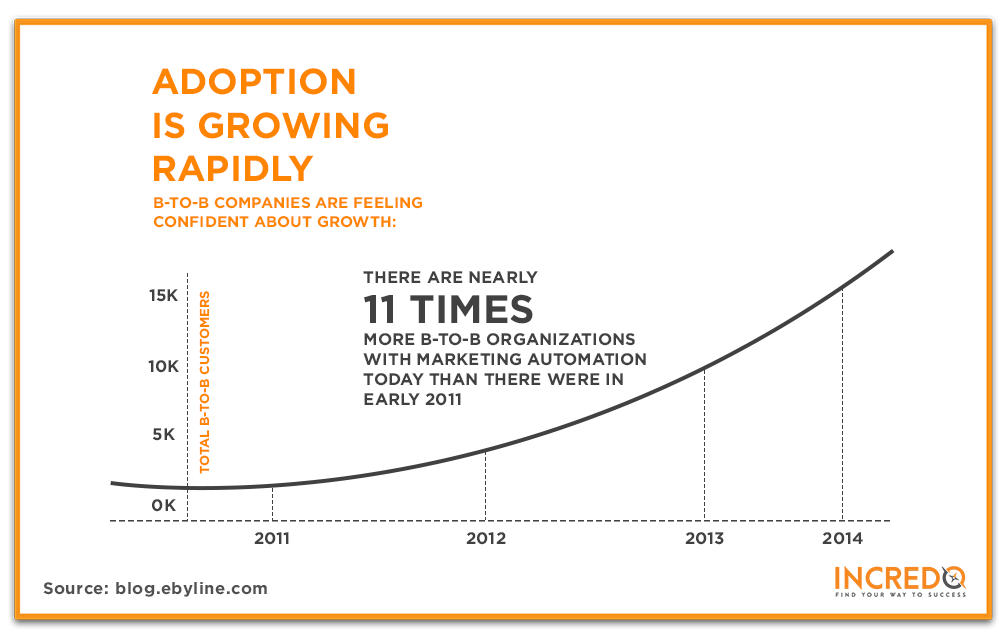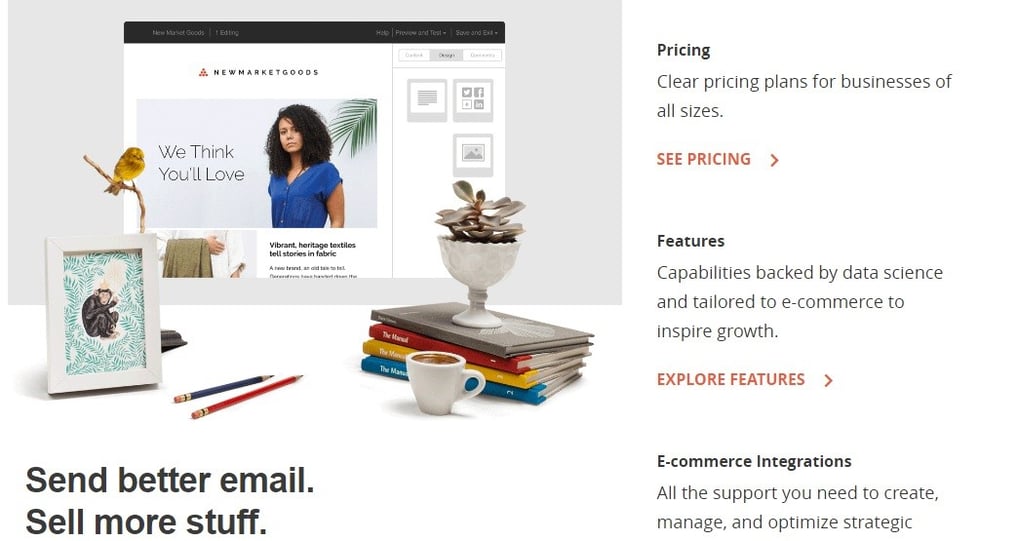The CMO’s Guide To Marketing Automation (It’s More Than Just An Email Tool)

The CMO’s Guide To Marketing Automation (It’s More Than Just An Email Tool)
The term marketing automation keeps gaining more and more popularity in the digital realm. Tools like Buffer, Mailchimp, Instapage, Unbounce, etc. have taken digital marketing by storm and keep increasing their dominance further and further.
However, to this day, a lot of marketers find the two terms rather contradicting and one could argue that they have a point. The thing is that marketing has always been about creativity and understanding your audience to showcase your product in a light that would shine brightest before their eyes, and automation kind of points to the opposite – after all, we all know that a general approach to marketing isn’t a good idea these days. So, why do so many businesses even use marketing automation in the first place? It’s important to know that marketing automation doesn’t refer to the whole marketing strategy that a business has, and it’s mostly limited to emails, social media and landing pages. Here is why:
It’s important to know that marketing automation doesn’t refer to the whole marketing strategy that a business has, and it’s mostly limited to emails, social media and landing pages. Here is why:
1. Email automation
Emails come in many shapes and forms for different businesses including welcome emails (popular among all software businesses), reminders (used by ecommerce), newsletters, personalized email campaigns (used for lead nurturing), emails offering downloadable material (these are basically tied to landing page contents), confirmation emails (ecommerce again), and a whole lot of others. Now imagine that you operate an ecommerce store and need to welcome new customers, confirm payments and orders, inform customers whenever their items are shipped and reach out to specific customers with relevant discount offers. It would be a total disaster if you tried to execute all of this manually. This is where automation steps in to help. With just a few clicks, you can coordinate a software to segment your audience based on where they come from (blog, product purchase, landing page, etc.) and automatically send out corresponding emails to as many people as you need, at the time you need.
Example: Automating personalized emails with Mailchimp
 Source: https://mailchimp.com/ To be more specific, here an awesome automation tactic you can leverage in your marketing strategy using Mailchimp. Customers value a personal touch, so naturally, marketers need to segment their audience in way that will help them send emails based on where customers are in their Buyer’s Journey. For instance, if a potential customer is still trying to evaluate his options, product comparison content is a good idea, while a person in his decision stage will prefer some pricing information. The lead scoring mechanism allows to segment your audience by awarding points to your leads, based on predefined criteria. For example, you could rank your leads by definitive terms like “Warm”, “Cold”, “Sales-ready”, “Customer”, etc. Based on the set criteria, your leads and customers will get their scores automatically, without any need for intervention. Now, to set your criteria correctly (how does the software know if a lead is “cold” or “sales ready”?), you need to create your lead scoring model. The lead scoring model is usually based on individual and company demographics (age, gender, personal interests, job information, etc.) and behavior on your website (returning visitor, purchased a product, completed an order, purchased an upgrade, etc.) Using this information, you can define the criteria that you need and use Mailchimp to send appropriate emails to each group of leads and customers. If you need more details, here is a great guide on how to create a sample campaign using lead scoring.
Source: https://mailchimp.com/ To be more specific, here an awesome automation tactic you can leverage in your marketing strategy using Mailchimp. Customers value a personal touch, so naturally, marketers need to segment their audience in way that will help them send emails based on where customers are in their Buyer’s Journey. For instance, if a potential customer is still trying to evaluate his options, product comparison content is a good idea, while a person in his decision stage will prefer some pricing information. The lead scoring mechanism allows to segment your audience by awarding points to your leads, based on predefined criteria. For example, you could rank your leads by definitive terms like “Warm”, “Cold”, “Sales-ready”, “Customer”, etc. Based on the set criteria, your leads and customers will get their scores automatically, without any need for intervention. Now, to set your criteria correctly (how does the software know if a lead is “cold” or “sales ready”?), you need to create your lead scoring model. The lead scoring model is usually based on individual and company demographics (age, gender, personal interests, job information, etc.) and behavior on your website (returning visitor, purchased a product, completed an order, purchased an upgrade, etc.) Using this information, you can define the criteria that you need and use Mailchimp to send appropriate emails to each group of leads and customers. If you need more details, here is a great guide on how to create a sample campaign using lead scoring.
2. Social media automation
Social media is the fastest growing trend in the history of the world. With over 200 social media networks and billions of users, marketers simply can’t manually keep a business page active on a few channels all at once. In fact, maintaining a constantly active Twitter account alone would take a full time job, so you would need a whole team of social media experts working constantly on each separate network, and that’s not exactly what we call efficient. Marketing automation allows to bypass these barriers as well, giving businesses a chance to automatically post marketing messages on multiple networks at once, while also increase engagement with your followers and leads. This allows marketers to create their messages once, and reuse them as many times as needed, or tweak those according to newly acquired marketing data in seconds, instead of wasting hours of time on repeating activities.
Example: Automating content curation with Buffer
 Source: buffer.com Finding and sharing relevant content on social media, as well as maintaining active engagement with your audience is crucial to social media success. However, sharing content and engaging with fans and followers on different networks manually can be a real pain and also, time zones are a big problem. For example, when you are posting on Twitter, you need to make sure that you are posting at a time when your audience is most active on. The average lifespan of a tweet is 18 minutes (and it’s getting shorter and shorter each year), and if you are not careful, all your hard work will go to waste, simply because nobody will be there to see or react to your tweet. Also, there is the question of how much content you should share. Some experts suggest to go with the rule 5-3-2 when sharing content, which means that for each 10 posts you share on one social media networks:
Source: buffer.com Finding and sharing relevant content on social media, as well as maintaining active engagement with your audience is crucial to social media success. However, sharing content and engaging with fans and followers on different networks manually can be a real pain and also, time zones are a big problem. For example, when you are posting on Twitter, you need to make sure that you are posting at a time when your audience is most active on. The average lifespan of a tweet is 18 minutes (and it’s getting shorter and shorter each year), and if you are not careful, all your hard work will go to waste, simply because nobody will be there to see or react to your tweet. Also, there is the question of how much content you should share. Some experts suggest to go with the rule 5-3-2 when sharing content, which means that for each 10 posts you share on one social media networks:
- 5 should be from others, relevant content to your audience
- 3 should be from you, relevant content to your audience
- 2 should be more personal/non-work related, to help humanize your brand
 As you probably noticed, this is too much manual work for one person. Even two persons. Or Three. Buffer allows you to connect up to five social media networks to your account, and schedule social media messages and posts to go off automatically, at the best time you need them to. Here is a detailed guide on social media automation that you might want to check out.
As you probably noticed, this is too much manual work for one person. Even two persons. Or Three. Buffer allows you to connect up to five social media networks to your account, and schedule social media messages and posts to go off automatically, at the best time you need them to. Here is a detailed guide on social media automation that you might want to check out.
3. Landing page automation
Previously, to create a landing page, every marketer needed to either have a sizable amount of coding knowledge or hire a developer to help him out. Not anymore. The third biggest (and probably the most useful) automation sphere – landing pages – allows businesses to create landing pages copies in seconds, using premade templates offered by their software vendor, and copying the initial design over and over again. You can also quickly create your own landing pages via the drag-and-drop method, bypassing all kinds of coding in the process.
Example: Building, publishing and testing landing pages with Unbounce
 Source: unbounce.com Unbounce is one of those tools that allows marketers to create beautifully designed landing pages in just a matter of minutes, without any coding knowledge. You can choose to use a predefined template taken from their library, or create your own landing pages with drag-and-drop features. What’s good about Unbounce, is that you can choose to build your desired landing page once and later re-use it over and over again (automate the process). Also, seamless integrations with your analytics, CRM and email marketing tools allow to automate even more actions based on what you need (like including landing pages/forms directly in your emails, or analyzing page performance and making corresponding tweaks), and run A/B tests to craft your highest converting landing page. Here is a detailed guide on how to effectively create/duplicate a landing page with Unbounce.
Source: unbounce.com Unbounce is one of those tools that allows marketers to create beautifully designed landing pages in just a matter of minutes, without any coding knowledge. You can choose to use a predefined template taken from their library, or create your own landing pages with drag-and-drop features. What’s good about Unbounce, is that you can choose to build your desired landing page once and later re-use it over and over again (automate the process). Also, seamless integrations with your analytics, CRM and email marketing tools allow to automate even more actions based on what you need (like including landing pages/forms directly in your emails, or analyzing page performance and making corresponding tweaks), and run A/B tests to craft your highest converting landing page. Here is a detailed guide on how to effectively create/duplicate a landing page with Unbounce.
OK, cool. So…
What marketers should realize is that marketing automation isn’t aimed at destroying your creativity. On the contrary, it helps get rid of routine, boring and time consuming activities, allowing to sit down with your team and brainstorm a unique marketing strategy, instead of wasting time and money.
The real strength of marketing automation
Automating emails, social media messages and engagement, along with replicating landing page design in seconds is good, but that’s not all you can get out of it. The thing is that marketing data and metrics are of outmost importance to any sharp marketer, who is trying to base his decisions on actual customer data rather than gut and subjective thinking. This is where user behavior analytics and marketing analytics become important. Some of the best tools that offer analytics software and might be good to take a look at, are Kissmetrics (focused on customer behavior) and Crazy Egg (focused on visual analytics and heatmaps). Lastly, a solid CRM software is needed to store and manage your customer data, so that you can run tests and analyze consumer behavior, using analytical tools. Now if you combine these three aspects together, you get a formula where marketing automation truly shines. One of the first companies that was able to pull this off (and is the industry leader to this day) is HubSpot, the all-in-one marketing automation tool. Having all your marketing data, analytics and automation tools gathered in one place is a tremendous time saver, and helps you truly get the most out of marketing automation. Not only that, but all-in-one marketing automation helps align your sales and marketing activities, where all actions and strategies of each team is transparent to the other, and helps create room for truly coordinated effort. Here is a detailed article on how to use HubSpot for your digital marketing strategy. Marketing automation isn’t just an email or social media tool: it’s technology that’s necessary for every business nowadays, and helps save precious time on routine activities. Using marketing automation doesn’t simply mean abandoning all creativity and mindlessly scheduling social media posts and emails (in fact, this is the worst thing you can do!), but getting rid of time-consuming stuff, so that you can focus on what really matters.
Tags:
SaaS Growth
October 7, 2016


Comments